Are There Shade Flowers For Butterfly Garden
Gardening in the shade has the reputation of being difficult, but it doesn't have to be. By choosing the right shade-loving plants, it's possible to have a beautiful landscape even in limited light. Some of the most popular garden plants are reliable standbys for a reason: with the right location and care, they provide season-long enjoyment even for novice gardeners.
Here are some of the best shade plants to get you started on the road to a lush, shady oasis:
On this page: Foliage Plants | Flowering Plants | Trees | Online Learning
- FOLIAGE PLANTS FOR SHADE
- FLOWERING PLANTS FOR SHADE
- TREES FOR SHADE
- ONLINE LEARNING
- ELDERBERRY VARIETIES
FOLIAGE PLANTS FOR SHADE
Shadowland® 'Autumn Frost' hosta. Photo by Proven Winners.
HOSTA
Regarded as queen of the shade garden, and it's easy to see why. Hosta is grown for its attractive foliage in a wide variety of colors, patterns, shapes, and sizes ranging from teacup to truck tire-sized. This tough-as-nails plant is reliably hardy in colder zones, and performs best when provided with rich, well-amended soil and regular water. Many varieties tolerate deep shade and difficult sites, such as underneath trees. They combine well with many woodland plants that grow in shade, including coral bells, ferns, and columbine. These long-lived favorites will reward you with years of reliable color in the garden.
Height/Spread:
2 inches to 4 feet tall, 5 inches to 6 feet wide
Zones:
3-9
Plants to Try:
Shadowland® 'Autumn Frost', 'Patriot', 'Blue Angel', 'Golden Tiara', or 'June'.
Learn more about growing hostas.
Primo® 'Peachberry Ice'. Photo by Proven Winners.
CORAL BELLS
For a nearly endless choice of foliage colors, patterns and forms, coral bells (Heuchera) fits the bill. From lemon yellow to nearly black, there's a hue to match every garden palette, making this a landscape designer's dream plant. The flowers that explode like fireworks above the foliage in late spring/early summer are just the icing on the cake. The easy-care nature of this semi-evergreen perennial—including tolerance of a wide variety of light and soil conditions—makes this an ideal choice for most landscapes. They perform best in rich, well-draining soil that stays evenly moist. Coral bells are a versatile design element, suitable for mixed borders, mass plantings and containers.
Height/Spread:
8 to 12 inches tall, 1 to 2 feet wide; flower stalks can reach 2 to 3 feet tall
Zones:
3-9
Plants to Try:
Primo® 'Peachberry Ice', 'Marmalade', 'Plum Pudding', 'Red Lightning'.
Learn more about growing coral bells.
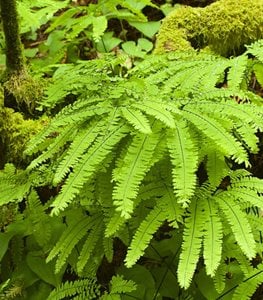
Maidenhair fern. Photo by Janet Loughrey.
FERNS
Ferns are some of the oldest living plants, dating back to the age of the dinosaurs. A must-have addition to any woodland or shade garden, these reliable perennials are grown for their attractive fronds that lend texture and form to the landscape. There are dozens of garden-worthy species that are adapted to a wide variety of conditions. Most require rich soil and plenty of moisture, though some such as Western sword fern (Polystichum munitum) are drought-tolerant after establishment, making them a good choice for challenging sites such as dry shade. Ferns pair well with nearly any woodland shade plant such as primrose (Primula), bishop's hat (Epimedium), hosta (Hosta), masterwort (Astrantia) and wood sorrel (Oxalis).
Height/Spread:
From the smallest fern in the world that measures just one-centimeter tall to tree-sized forms, there's a size to fit every landscape.
Zones:
There's a fern suitable to nearly every zone, from northern maidenhair fern (Adiantum pedatum, Z. 3) to species that thrive in tropical rain forests.
Plants to Try:
Japanese painted fern (Athyrium niponicum var. pictum), ostrich fern (Matteuccia struthiopteris), cinnamon fern (Osmundastrum cinnamomeum), maidenhair fern (Adiantum pedatum).
Heart to Heart™ 'Rose Glow'. Photo by Proven Winners.
CALADIUM
For an exotic feel in the garden, few plants rival the bold impact of angel wings (Caladium). Made popular as a Victorian conservatory plant, this tropical annual is grown for its arrow-shaped leaves in hues from pure white to multi-colored variegation. It's most valuable for adding vibrant color to the darkest corners of your yard where bright colors can be scarce. Caladium can be grown from tubers or purchased as plants. Since they require a lot of heat to grow, they will do best when obtained as plants for those in cooler climates or without a heat source such as a greenhouse or heating mat. Grow as a bedding plant or in containers and combine with impatiens, begonias, and fuchsias.
Height/Spread:
6 inches to 3 feet tall, 1 to 2 feet wide
Zones:
10-11
Plants to Try:
Heart to Heart™ 'Rose Glow', 'Miss Muffet', 'White Queen', 'Red Flash'.
Learn more about growing caladium plants.
ColorBlaze® Rediculous™ coleus. Photo by Proven Winners.
COLEUS
One of the most popular summer annuals is coleus (Plectranthus, syn. Solenostemon), grown for its foliage that comes in a never-ending array of patterns, forms and colors. Coleus prefer rich soil that drains well and regular water, and can easily be reproduced from cuttings. Foliage color is best when planted in areas that get some direct light in the morning and protection from hot afternoon sun. This tropical is extremely versatile as a design element; use as a stand-alone accent, massed as bedding plants, or in front of a mixed border. Combine in containers with flowering annuals such as million bells, impatiens, or fuchsia.
Height/Spread:
2 to 5 feet tall, 3 feet wide
Zones:
10-11
Plants to Try:
ColorBlaze® Rediculous™, ' 'Black Dragon', 'Campfire', 'Wizard'.
Learn more about growing coleus.
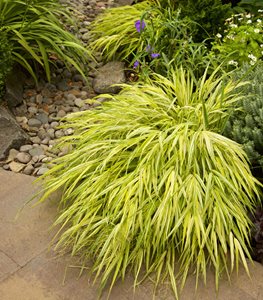
Golden Japanese forest grass. Photo by Janet Loughrey.
JAPANESE FOREST GRASS
One of the few ornamental grasses that thrives in shade is Japanese forest grass (Hakonechloa macra). This deciduous perennial grows in low, mounding clumps. Golden or variegated species are valuable for lighting up darker areas with their foliage. Tolerant of varying light conditions from partial sun to deep shade, Japanese forest grass prefers rich, well-draining soil and regular moisture. Design uses are many: grow as a groundcover, massed along a slope, as a foundation planting, in containers or in the front of a mixed border. The graceful, arching habit and flowing leaf texture contrasts beautifully alongside hostas, hellebores, ferns and coral bells.
Height/Spread:
1 to 2 feet tall, 2 feet wide
Zones:
5-9
Plants to Try:
'Aureola', 'All Gold', 'Albo Striata', 'Nicolas'.
See more foliage plants: Proven Winners: Fab Foliage Plants for Shady Spaces
FLOWERING PLANTS FOR SHADE
Proven Accents® Pink Chablis®. Photo by Proven Winners.
DEADNETTLE
Deadnettle (Lamium) is an easy care, reliable groundcover that's grown for its attractive multi-seasonal foliage and spring-blooming flowers of pink, white, or lavender. The light-colored silver, white, yellow, or variegated foliage is effective for brightening deeply shaded areas. This deciduous or semi-evergreen perennial thrives in a wide range of conditions, though it does best with partial to full shade and well-amended soil. This creeping groundcover fills in quickly and can grow in difficult sites such as under trees or in dry shade, providing a carpet of color throughout the growing season. Grow on a slope, in larger areas in need of quick-growing vegetation, at the front of a mixed border, or in containers. Deadnettle can grow aggressively in certain areas. See where it has been identified as invasive.
Height/Spread:
3 inches to 2 feet tall, 3 feet wide or greater
Zones:
4-9
Plants to Try:
Proven Accents® Pink Chablis®, 'White Nancy', 'Golden Anniversary', 'Beacon Silver', 'Chequers'.
'Cutting Edge' foamflower. Photo by Proven Winners.
FOAMFLOWER
Foamflower (Tiarella), a classic woodland plant indigenous to North America, makes a welcome addition to any native garden. The delicate habit of this dainty semi-evergreen perennial belies its toughness and reliability. Grown for its frothy flowers that bloom over an exceptionally long time, the heart-shaped, lobed leaves in various patterns provide color year-round in milder regions. Foamflower tolerates deep shade, but performs best with dappled light that simulates their native woodland habitat. Plant in containers, rock gardens, or massed as a groundcover. Combine with other spring bloomers such as violets, Siberian bugloss (Brunnera), creeping phlox, and bleeding heart.
Height/Spread:
8 to 12 inches tall, 1 to 2 feet wide
Zones:
4-9
Plants to Try:
'Cutting Edge', 'Crow Feather', 'Jeepers Creepers', 'Neon Lights', 'Pink Skyrocket'.
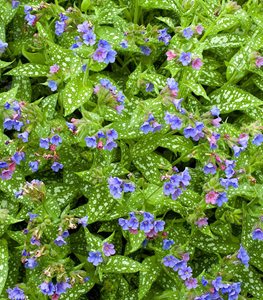
'Bertram Anderson' lungwort. Photo by Janet Loughrey.
LUNGWORT
One of the most welcome sights in spring is the delightful flowers and foliage of lungwort (Pulmonaria). Among the earliest perennials to bloom, the showy flowers—in shades of blue, pink, coral, and white—emerge simultaneously with the attractive green, spotted or silver foliage that grows ever larger as the season progresses. This woodland favorite prefers rich soil and regular moisture, performing well even in boggy sites. Combine with bleeding heart, hosta and spring-flowering bulbs for an uplifting display after the long, cold winter.
Height/Spread:
6 to 12 inches tall, 1 to 2 feet wide
Zones:
3-9
Plants to Try:
'Dark Vader', 'Raspberry Splash', 'Bertram Anderson', 'Sissinghurst White'.
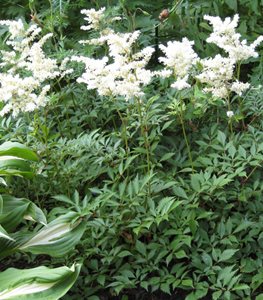
'Bridal Veil' astilbe. Photo by Sylvain Marineau / Millette Photomedia.
ASTILBE
Astilbe is a favorite of gardeners for its showy flower plumes that appear in summer after many other woodland plants are finished blooming. The flowers of this deciduous perennial occur in hues of violet, pink, white and red, blooming above the delicate ferny foliage, making this a real standout in the woodland garden. Astilbe prefers rich soil that stays constantly moist, and blooms best with part-day sun. Mass as a ground cover in a woodland garden or shade border, or plant in containers. Combine with ferns, coral bells and hostas.
Height/Spread:
1 to 4 feet tall and wide
Zones:
Most 4-8
Plants to Try:
'Sprite', 'Visions', 'Bridal Veil', 'Ostrich Plume'.
Learn more about growing astilbe.
Invincibelle Wee White® smooth hydrangea. Photo by Proven Winners.
HYDRANGEA
Hydrangea is one of the most revered garden plants, an old-fashioned favorite that blooms in summer and fall. This deciduous shrub comes in a wide range of species and forms, from the most popular mopheads (H. macrophylla) to hardy peegees (H. paniculata). Most prefer regular water and rich amended soil, though oakleaf hydrangea (H. quercifolia) is drought-tolerant in some areas once established. Flowers are blue, white, purple, pink or red, with some having variable color according to soil pH. Plant in a mixed border, as a stand-alone accent, or as screening along a property border. Smaller specimens can be planted in containers. Hydrangeas do prefer more bright shade than deep shade.
Height/Spread:
2 to 20 feet tall, 5 to 10 feet wide
Zones:
4-9
Plants to Try:
Oakleaf hydrangea (H. quercifolia), H. macrophylla 'Harlequin', H. paniculata 'Limelight', H. arborescens Invincibelle Wee White® .
Learn more about growing hydrangeas.
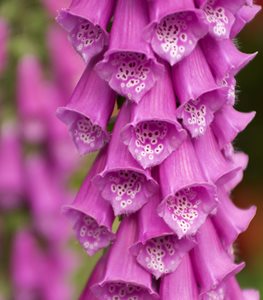
Common foxglove. Photo by Janet Loughrey.
FOXGLOVE
Foxglove (Digitalis) is a classic cottage-style favorite, grown for its statuesque spires of bell-shaped flowers that bloom in late spring and summer. The most common garden forms are biennial (D. purpurea), producing flowers in their second year. These self-sow readily for years of subsequent bloom, making them useful to fill in gaps. Other perennial species are a good choice for a mixed border. Foxgloves prefer rich, moist soil and bloom best when receiving at least part-day sun. Plant along a slope or naturalize in a woodland setting, cottage-style garden, or wildflower meadow.
Height/Spread:
3 to 8 feet tall, 1 to 3 feet wide
Zones:
3-8
Plants to Try:
Common foxglove (D. purpurea), strawberry foxglove (D. xmertonensis), rusty foxglove (D. ferruginea), sunset foxglove (D. obscura).
Learn more about growing foxglove.
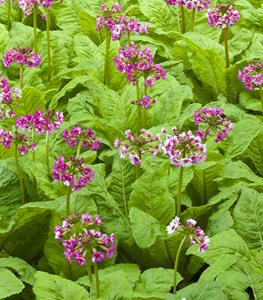
Japanese primrose. Photo by Janet Loughrey.
PRIMROSE
A sure sign of spring, primrose (Primula) is a welcome sight after a long, cold winter. The best known variety, English primrose (P. vulgaris), appears in garden centers in early spring with cheerful hues of blue, pink, red, yellow and orange. There are dozens of other garden-worthy species, all of which perform best in cooler climates. Primroses prefer rich, well-draining soil, regular water and partial sun to deep shade, though alpine types can tolerate more light and dryer conditions. They combine well with many other woodland plants, including ferns, hosta, iris and bleeding heart. Naturalize in a woodland setting, plant at the front of a mixed border, or in containers.
Height/Spread:
3 inches to 4 feet tall, 4 inches to 3 feet wide
Zones:
2-8
Plants to Try:
Japanese primrose (P. japonica), candelabra primrose (P. beesiana), drumstick primrose (P. denticulata), cowslip (P. veris).
Infinity® Pink Frost New Guinea impatiens. Photo by Proven Winners.
IMPATIENS
A top choice of gardeners for shade bedding plants are impatiens (Impatiens walleriana), valued for their nonstop bloom from late spring through frost. These tropical annuals come in a wide array of colors and are fast-growing, quickly filling in large areas. Impatiens prefer rich, well-draining soil, regular water, and are relatively low maintenance, requiring no deadheading. In recent years, downy mildew has become a greater problem, so other disease-resistant forms such as New Guinea impatiens and SunPatiens® offer a viable substitute. Breeders are working to develop other mildew-resistant forms, which will soon become available to home gardeners. Mass in beds, plant at the front of a border, or in containers.
Height/Spread:
1 to 3 feet tall and wide
Zones:
10-11
Plants to Try:
New Guinea impatiens (I. hawkeri), SunPatiens® (I. xhawkeri), jewelweed (I. capensis).
Learn more about growing impatiens.
'Gold Heart' old-fashioned bleeding heart. Photo by Proven Winners.
BLEEDING HEART
Few shade flowers rival the romance and intrigue of bleeding heart (Lamprocapnos syn. Dicentra spectabilis). The white, pink, or red heart-shaped flowers are borne on arching stems above fern-like leaves. The most commonly grown variety of this deciduous perennial is L. spectabilis (syn. Dicentra spectabilis), a spring ephemeral that dies back in summer. Plant these alongside hosta or other bold-leafed plants that will grow up and cover the dying foliage. Bleeding heart grows best in rich, well-draining soil with regular moisture. For longer-lasting plants, the foliage and flowers of fringed bleeding heart (D. eximia) or western bleeding heart (D. formosa) will last into fall with regular watering. Grow in a woodland setting with other shade lovers, or in a container as a dramatic focal point.
Height/Spread:
6 inches to 3 feet tall, 1 to 3 feet wide
Zones:
3-9
Plants to Try:
'Alba', 'Gold Heart', 'Valentine', 'Luxuriant'.
Learn more about growing bleeding heart.
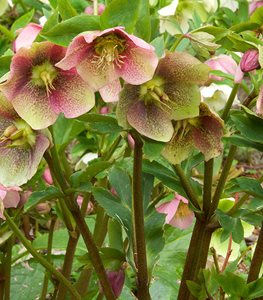
Hellebore hybrid. Photo by Janet Loughrey.
HELLEBORE
Hellebores (Helleborus) are coveted by avid gardeners for their exceptionally long bloom time, cup-shaped flowers and attractive evergreen foliage. Christmas rose (H. niger) is the first to bloom, beginning in December in milder regions, hence its name. Thanks to recent breeding breakthroughs, the most commonly grown species (H. xhybridus)—which blooms from late winter into spring—comes in a dizzying array of colors and patterns. These tough plants prefer rich, well-draining soil, tolerate varying light conditions, and are virtually carefree once established. Naturalize in a woodland setting, plant in front of a mixed border, or in containers. Combine with anemone, hosta, trillium and daffodils.
Height/Spread:
1 to 4 feet tall, 1 to 3 feet wide.
Zones:
4-9
Plants to Try:
Stinking hellebore (H. foetidus), Corsican hellebore (H. argutifolius), Winter Jewels®, 'Pink Frost'.
Learn more about growing hellebores.
TREES FOR SHADE
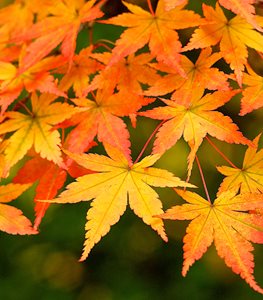
Japanese maple. Photo by Janet Loughrey.
JAPANESE MAPLE
Among the most beloved ornamental trees, Japanese maples (Acer palmatum) are grown for their multi-seasonal interest, elegant structure and brilliantly colored foliage in shades of red, orange, yellow and purple. While some varieties grow into medium or tall trees, others stay smaller, making them suitable for urban lots. These deciduous trees do best when planted in rich, well-draining soil, and with regular water and protection from hot afternoon sun. Use as a backdrop in a mixed woodland border or as a stand-alone focal point. Smaller specimens can be planted in containers.
Height/Spread:
3 to 30 feet tall, 3 to 25 feet wide
Zones:
5-8
Plants to Try:
A. palmatum 'Bloodgood', A. palmatum 'Sango-kaku', A. japonicum 'Aconitifolium', A. palmatum 'Shishigashira'.
Learn more about growing Japanese maple trees.
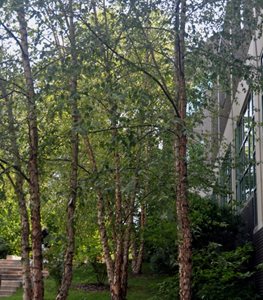
Dura-heat® river birch. Photo by Marietta Paternoster Garr / Millette Photomedia.
BIRCH
For natural woodland appeal, birch (Betula) trees make a valuable addition to the landscape for their elegant stature, fall color, and ornamental bark that is particularly attractive in winter. Some varieties are extremely hardy, making them a good choice in colder regions. These deciduous trees are fast growing and perform best in rich, well-draining soil with regular water and at least part-day sun. Because there are so many options to choose from, it's important to research which ones will do best in your region, and to choose a variety that will not outgrow its space. Plant near a stream or pond, in a row to divide garden spaces, group as an allée, or use a single specimen as a backdrop in a mixed border.
Height/Spread:
5 to 80 feet tall, 5 to 40 feet wide
Zones:
2-9
Plants to Try:
B. papyrifera (paper birch), B. nigra (river birch), B. pendula (weeping birch), B. populifolia ('Whitespire' grey birch).
Learn more about growing birch trees.
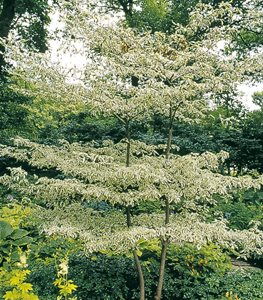
Pagoda dogwood. Photo by Bertrand Dumont / Millette Photomedia.
DOGWOOD
Grown for its showy flowers and statuesque habit, dogwood (Cornus) is synonymous with spring. While most are deciduous trees, there are also shrub and groundcover forms. Tree varieties most available to home gardeners tend to be small to medium-sized, making them suitable to urban lots and curbside strips where power lines are a concern. Some varieties prefer full sun, though others are suited to the dappled shade of their native woodland habitat. Use as a backdrop or focal point in a mixed border, or as a stand-alone focal point in a lawn. Grow with compatible understory plants such as daffodils, sweet woodruff, hosta and ferns.
Height/Spread:
10 to 50 feet tall, 6 to 50 feet wide
Zones:
4-9
Plants to Try:
C. alternifolia (pagoda dogwood), C. controversa 'Variegata' (wedding cake tree), C. kousa (kousa dogwood), C. florida f. rubra (Eastern dogwood).
Learn more about growing dogwood trees.
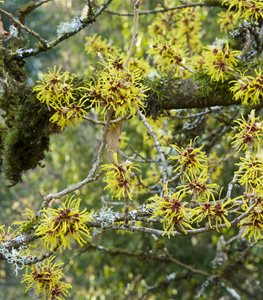
Chinese witch hazel. Photo by Janet Loughrey.
WITCH HAZEL
In the dead of winter when there is little life in the garden, the delicate ribbon-like flowers of witch hazel (Hamamelis) cheer up even the dreariest days. The graceful vase-shaped structure is just a bonus, with some varieties having additional attributes of fall color or fragrance. This deciduous tree or shrub needs virtually no care once established, with most suitable for small spaces. Grow as a stand-alone focal point, along a property border, or near your home's entrance or sidewalk where the fragrance can be enjoyed up close. Smaller specimens can be grown in containers. Combine with other plants with winter interest such as hellebores, snowdrops, and heathers.
Height/Spread:
12 to 15 feet tall and wide
Zones:
3-9
Plants to Try:
H. xintermedia'Jelena', H. xintermedia 'Aphrodite', H. xintermedia 'Diane', Chinese witch hazel (H. mollis).
Learn more about growing witch hazel.
ONLINE LEARNING
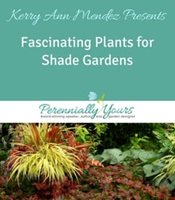
FASCINATING PLANTS FOR SHADE GARDENS
Plant expert Kerry Ann Mendez introduces you to a wide variety of perennials, flowering shrubs, annuals, bulbs and flowering vines for shade gardens in Zones 3 to 8. Get design tips and plant combinations that will have you eager to plant up the shady spots in your garden.
RELATED:
19 Amazing Shade Annuals
Container Gardens Made for the Shade
Shade Garden Pictures
Are There Shade Flowers For Butterfly Garden
Source: https://www.gardendesign.com/shade/plants.html
Posted by: newmanabings1964.blogspot.com

0 Response to "Are There Shade Flowers For Butterfly Garden"
Post a Comment